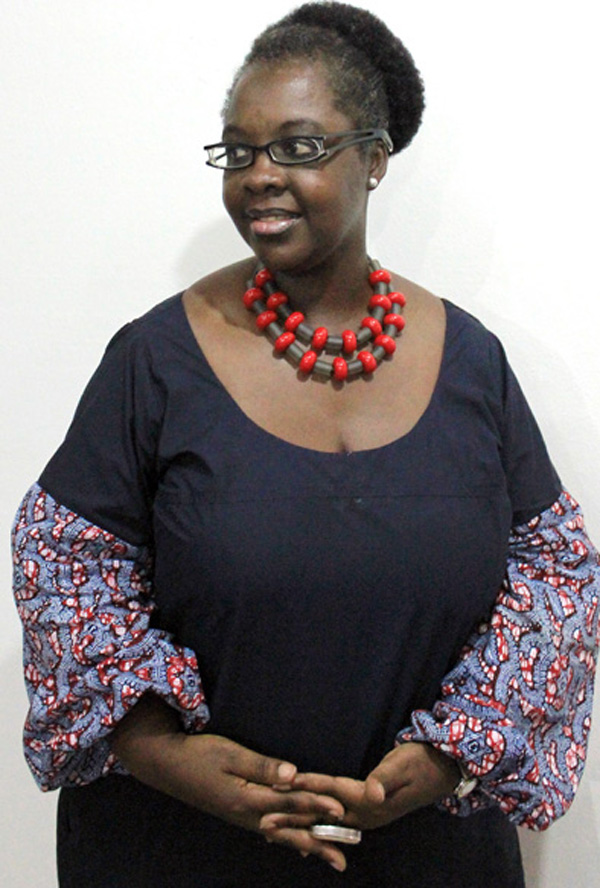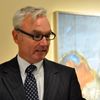
This third edition of Marker, curated by Lagos-based Bisi Silva for the seventh edition of Art Dubai, describes the societal changes sparked by the rapid development of West African cities. The founder and artistic director of the Centre for Contemporary Art, Lagos, she chose five West African artspaces -- Centre for Contemporary Art (Lagos, Nigeria); Espace doual'art (Douala, Cameroon); Maison Carpe Diem (Ségou, Mali); Nubuke Foundation (Accra, Ghana); and Raw Material Company (Dakar, Senegal) for her project. These artspaces feature such artists as Soly Cisse (Senegal), Ablade Glover (Ghana), Abdoulaye Konaté (Mali), Boris Nzebo (Cameron), and Taiye Idahor (Nigeria).
JS: What in your background has prepared you to curate this Marker show?
BS: Since 2007 I have also been the director of the Centre for Contemporary Art, Lagos curating and organizing exhibitions and projects with national, regional, continental and international artists, curators and institutions. This is coupled with nearly two decades of professional practice. My focus has been on contemporary art generally and within that my area of interest and research being Africa and the global south. On a formal level I think my postgraduate education in Curating of Contemporary Art from the Royal College of Art is a good starting point for curatorial practice.
JS: Explain the development of your "cities in transition" theme? How is it significant? How does it fit in with your interest with Diasporic art?
BS: I think this is an appropriate theme considering that over the last half century both regions have witnessed an unprecedented evolution in the way in which people live. It is one of the most fascinating and phenomenal sites where change manifests in our countries today. In considering the process of rural to urban migration, the collusion between tradition and modernity, the blurring the spatial boundaries between the public and private, it is palpable the way these changes are impacting on the way we live and think. A subtheme is also that of the environment and the way in which man's actions affects nature in a detrimental way. These everyday realities and lived experiences are reflected in the work of many artists across the region and the continent. However, they are not local issues or concerns but global preoccupations and I believe this makes the focus relevant within the context of Art Dubai.
JS: Why specifically did you ask these particular artspaces to curate exhibitions for Marker?
BS: The choice of the organisations is premised on the professional interactions and collaboration that I have had with them over the past decade or so. Also they have spearheaded innovative initiatives and projects which have impacted in important ways on their local art context many in the face of total governmental inaction. Whilst Doual'Art has been active for about twenty years, several new organisations such as Raw Material, Dakar, Centre for Contemporary Art, Lagos and Nubuke Foundation, Accra have been initiated over the past decade across the region. Chab Toure, director of Maison Carpe Diem, Segou, Mali opened the only photography gallery and bookshop in Mali in the early 1990s. These organisations have also worked with artists and curators whose work engages or explores the idea of the city and Marker presents an opportunity to work together.
JS: Is there a common link that runs through the work of the artists on display? Does the work mirror the society from which it sprang, or is it more global in conception if not execution?
BS: I believe that art mirrors the society from which it emanates as well as accommodating the life experiences of the individual artist. Most of the galleries and the artists will have a common link but from a diversity of perspectives. For example Doual'Art organizes a major programme, a triennial called SUD (Salon Urbaines de Douala) with the 3rd iteration coming up this year, which focuses on the urban context and art in public places. One of the artists they have worked with Joseph Francis Sumegne - whose work will be presented at Marker - has a huge permanent sculpture in a strategic location in the city centre of Douala. Nubuke Foundation will present the work of one of Ghana's established artist Ablade Glover, famous for his vivid painterly cityscapes. Many of the artists including Amahiguere Dolo and Abdoulaye Konate from Mali, Ade Adekola, Ndidi Dike and Taiye Idahor from Nigeria, as well as Henri Sagna and Soly Cisse from Dakar deal directly with or make allusions to the rapidly changing modernizing cities and the impact not only on the way we live but also on the environment.
JS: Can you draw parallels - social, political, economic, and cultural - between art produced in West Africa and that produced in the Middle East? The Middle East has its Arab uprisings. Is there something similar, operating now or in the recent past, that informs the collective subconscious of the West African artist?
BS: We have followed - like the rest of the world- the incredible effects of the uprisings in the Middle East and I think it has impacted indelibly on our own political consciousness and social responsibilities. Whilst the power of communication technology has been an unparallel change medium, it is through the Arab spring that we have considered it as a powerful tool for social and political change. In Nigeria it was effective in 2011 in reserving an 150% hike in petrol price and in Senegal made sure that the then president did not become a life president. These experiences are reflected in artists work across the region in their drawings such as Karo Akpokiere, collection of twitter messages by sound and video artist Emeka Ogboh both in presented in Marker and in the images of many photographers across the region.
'Cities in Transition' is an appropriate theme for Marker and Art Dubai considering that over the last half century both regions have witnessed an unprecedented evolution in the way in which people live. This manifests in the continuing transition from the nomadic and the rural to the more sedimentary and urban conurbations that we witness sprouting up around us with alacrity and the attendant consequences and impact on the environment. It also provides an opportunity to introduce the complex historical and social dynamics of West African cities to Art Dubai's visitors for the first time. This evolving urban ecology has greatly impacted many artists in West Africa and we felt that it would be well understood and received within the Middle-Eastern context.
An even longer interaction can be traced in the history of migratory trade during the trans-Sahelian trade routes from the 10th to the 19th century. This period witnessed the movement of goods (salt and gold) as well as human beings between West Africa and North Africa but also extended to the Mediterranean and the Middle East and even Asia. The history of West Africa and these regions are inextricably linked and I find this extremely fascinating. A recent article by a colleague highlighted the cultural legacy of Afro-Emiratis an area of research which has yet to be fully explored - to my knowledge - by either African and Emirati artist or even curators.
JS: What's your assessment of the West African art world in terms of artists, curators, critics, historians, galleries, and collectors? Is it thriving? How so? If not, why not? What work needs to be done? What impact do you think your participation in Marker will have on global perceptions of West African Art?
BS: West Africa has some of the most incredible artistic and cultural heritage in the world. Nigeria is famed for its Benin Bronzes, its Noks Terracotta, its Ife Bronzes. They remained unparalled anywhere in the world. In Mali and Ivory Coast we have the Baule and Fang Masks as well as Dogon sculptures to name a few. In spite of slavery, colonial and other foreign incursions which have contributed to the destruction of this culture, they, nonetheless, form part of a heritage that we claim today and that influences contemporary art. This is visible in the textile installations by Malian artists Aboubakar Fofana and Abodulaye Konate as well as in the sculptures of Amahiguere Dolo influenced by Dogon cosmology.
Art infrastructure - physical and intellectual - is still in an embryonic stage and each country has different structures. For example in Nigeria we have over 25 faculties of fine and applied arts at tertiary level offering under and postgraduate art degrees, whereas in other countries they may be only one or two institutions offering academic art courses. Whilst Nigeria does have a growing and vibrant commercial gallery system and collector base much needs to be done. However modern and contemporary art from West Africa remains under-represented internationally and the opportunity that Marker affords is an appropriate platform that will contribute to its increasing visibility.
JS: What's the role of West African art criticism? Is it undergoing any manner of recent transformation? In your opinion, beyond descriptive prose does it provide an adequate context for contemporary work? Do you feel that the art needs sophisticated criticism to develop?
BS: I believe more opportunities need to be done with regards to art criticism in West Africa. The Dakar biennale in Senegal has been central in its development over the past decade as they have organised several art criticism workshops mainly for art journalists from several West African countries as part of their educational programmes and in preparation before each biennale event. The Bamako African photography biennale in Mali also has a programme targeting photography criticism. These initiatives have contributed in introducing art writers to a wide diversity of artistic practice and artists as well as writing tools. The opportunities to develop art criticism is extremely limited in most countries with only a handful of critics and in most cases no art magazines or journals. In Nigeria we have writers who are members of the International Association of Art Criticism, have undertaken doctoral research in modern and contemporary Nigerian art and it is not uncommon to have 'heated' debates in the newspapers about art. Most universities had some form of printed platform for academic art writing but that dwindled in the late 80s with repression of intellectual activity by the military dictatorship and many academics fleeing the country.
However, most Nigerian newspapers have an Arts page and visual art is an integral part of that section. In addition to the staff art journalists, the section is complemented by guest writers and columnists. Art definitely needs constructed criticism to develop and I believe each context determines at what level it is appropriate for their locality and this will differ from one place to another.
JS: What's your next project after Art Dubai?
BS: An important focus for me in regional collaboration and the next project comes up in May in Accra, Ghana. It is a 35 day intensive international art programme in the form of an art incubator for emerging artists from across the continent. About 15 artists from 8 African countries come together with a faculty of nearly 20 international artists, curators, art historians and art critics for the programme entitled The Archive: Static, Embodied, Practiced. Over a one- month period it will involve seminars, lectures, art and writing workshops, critiques, curatorial course and a final presentation using the Archive as the underpinning theme. This will be the third year of the programme and the first time that it moves outside of Nigeria. We hope it can be developed as a roaming pan African informal art academy. That is my next major project.

